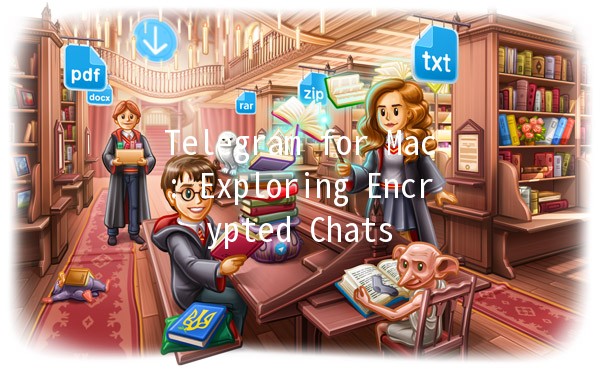Telegram for Mac: Exploring Encrypted Chats 🔒💬

In an age where digital communication is an integral part of our lives, the need for privacy and security has never been greater. With countless messaging apps available, Telegram has distinguished itself as a leading choice for users who prioritize secure communication. This article delves into encrypted chats on the Mac version of Telegram, covering the app's features, advantages, and practical tips to enhance your experience, all while ensuring that your conversations remain confidential.
Understanding Telegram's Security Features
Telegram has garnered a reputation for its robust security measures. The platform employs various encryption methods to safeguard user data. Here are the key features that contribute to its reputation:
One of the standout features of Telegram is its endtoend encryption (E2EE) for Secret Chats. Unlike regular cloud chats, where messages are stored on Telegram's servers, Secret Chats are designed for users who want their conversation history to remain private. This means only the sender and receiver can access the messages, making it impossible for third parties, including Telegram itself, to intercept the content.
Telegram's encryption protocol, MTProto, is specifically designed for speed and security. It utilizes a mix of symmetric and asymmetric cryptography to ensure that data cannot be tampered with during transmission. This unique approach makes Telegram resilient against various cyber threats.

For those who desire an additional layer of privacy, Telegram offers selfdestructing messages in Secret Chats. Users can set a timer for messages to disappear after they have been read, significantly reducing the chances of sensitive information being compromised.
To further protect your account, Telegram allows users to enable twostep verification. This adds an extra layer of security by requiring a password in addition to your phone number for account access. This ensures that even if someone has your SIM card, they cannot access your Telegram account without the additional password.
Setting Up Telegram on Mac
Getting started with Telegram on your Mac is a seamless process. Here’s how you can install and set up the app to begin your encrypted chatting experience.
Visit the official Telegram website or the Mac App Store to download the Telegram desktop app. The app is lightweight and intuitive, making it easy for both novice and experienced users to navigate.
Once downloaded, open Telegram and follow the onscreen prompts to create a new account. You will need to enter your phone number, which will be used for verification. A code will be sent to your phone via SMS. Enter this code in the app to verify your account.
Telegram’s interface is userfriendly. The sidebar displays chats, groups, and channels. You can easily start a new chat by clicking on the pencil icon. Familiarizing yourself with the layout will enhance your overall experience.
Initiating Encrypted Chats
With your Telegram account set up, you can start your encrypted chats. Here’s how to do it effectively:
To initiate a Secret Chat on the Mac version of Telegram:
Click on the pencil icon in the upper right corner.
Select 'New Secret Chat.'
Choose the contact you wish to chat with.
Your Secret Chat will be established, and you can now communicate securely.
Once your Secret Chat is active, you can send messages as usual. To use the selfdestruct feature:
Tap on the contact’s name at the top of the chat.
Set the selfdestruct timer from 1 second to 1 week.
All messages sent within this timer will automatically delete after they’ve been viewed.
Telegram also allows you to send photos, videos, and documents over Secret Chats securely. When sending media, it is encrypted just like your messages.
Enhancing Your Privacy on Telegram
While Telegram offers various builtin security features, there are additional steps you can take to enhance your privacy even further.
Navigating to 'Settings' in the app will allow you to configure your privacy options. Here, you can manage who can see your phone number, last seen status, and profile picture. Limiting access can help safeguard your online presence.
When participating in group chats, be mindful of the information you share. Telegram allows you to create private groups, ensuring that only invited participants can join. Use this feature to maintain control over your discussions.
Consider utilizing a VPN for extra protection when using Telegram, especially when on public WiFi networks. A VPN can help obscure your IP address and add another layer of security to your communication.
Comparing Telegram Encrypted Chats with Other Platforms
While Telegram offers robust encryption features, it’s beneficial to compare it with other popular messaging apps to understand its advantages fully.
WhatsApp has gained popularity for its endtoend encryption, but it has been under scrutiny for data privacy issues since its acquisition by Facebook. Telegram, conversely, maintains that user data is not stored, making it a more appealing choice for privacy enthusiasts.
Signal
Signal is another app known for its strong privacy features and opensource nature. While it offers excellent encryption, it currently lacks some of the flexibility and organizational features that Telegram provides, such as groups and channels.
iMessage
Apple's iMessage is also touted for its security, yet it is limited to Apple devices and requires users to have an Apple ID. Telegram, being crossplatform, appeals to a broader audience without the need for specific hardware.
As digital communication continues to evolve, the importance of secure messaging cannot be overstated. Telegram's Mac version provides a comprehensive platform for encrypted chats, prioritizing user privacy through various innovative features.
By utilizing Secret Chats, selfdestructing messages, and twostep verification, users can ensure that their private conversations remain confidential. Embracing these best practices will not only enhance your experience but also contribute to a more secure digital environment.
In today’s fastpaced world, where data breaches and privacy concerns loom large, using Telegram for encrypted chats on Mac is not just a choice but a necessity for anyone who values their privacy. So, download Telegram, start your secure conversations, and take control of your digital communication!
Other News

如何在TelegramX中进行群组投票 🤖📊

Telegram安装时间优化 🚀📱

Telegram Mac版下載地址及其特色功能探索!
